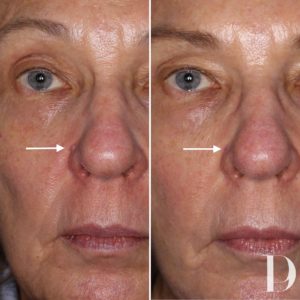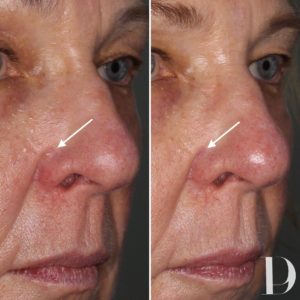CO2 mole removal

A large part of our work in medical dermatology involves examining patients to differentiate a benign mole (nevus) from one that shows suspicious changes. Once a thorough physical exam (and if needed a biopsy) has excluded skin cancer, many of our patients are left wondering what can be done to improve their cosmetic appearance, especially when a mole is situated on a visible body part or raised.
Though moles can be removed for cosmetic purposes with traditional surgery using a scalpel, a laser can be used to very precisely vaporize the mole. Laser therapy is especially suitable on facial moles.
What is the technology behind CO2 laser?
The CO2 laser is an ablative laser – this means that when the laser comes into contact with the skin, it vaporizes a very thin, precise layer on top of the mole and does not damage the surrounding tissue. This is repeated until the mole is level with neighboring skin, resulting in an improved cosmetic appearance.
Am I a candidate for CO2 mole removal?
Moles that catch on clothing, are bumpy or unsightly are often well-suited for cosmetic removal. CO2 laser is not suitable to treat suspicious moles. Patients with abnormal scars (including keloids) or darker skin types must be especially cautious when considering laser treatment. A cosmetic consultation in our office will allow our dermatologists to determine the best tailored approach for you.
What to expect on the day of your treatment
On the day of your treatment, consent forms will be reviewed and signed, and photos will be taken for documentation. In the treatment room, the area will be cleansed and local anesthetic will be injected to numb the mole (much like at the dentist’s office). This is the only discomfort during the procedure (don’t worry – I’m a big wuss who doesn’t like pain and I treat my patients how I want to be treated!). Your eyes will be shielded with special goggles while the laser is targeted on the skin. Thanks to the local anesthetic, this is painless. A smoke evacuator will be used during the procedure and it is slightly noisy, not unlike the sound of a vacuum cleaner – this is used to remove smoke and noxious odors produced during the laser treatment. You be offered to return for a follow-up appointment 4-6 weeks after your treatment.
Downtime & Recovery
The treated area is expected to heal within 4-10 days depending on its size. Healing starts with a small crust or scab – it is important that you keep the area hydrated with either Aquaphor or Vaseline ointment. Unlike what my grandmother has been telling me, leaving the treated area “exposed to the air” or “to dry” is NOT beneficial. The area will be covered with a small adhesive bandage (Band-Aid) after your procedure, and this can be done during your recovery if desired.
Like any procedure that breaches the skin, there is a small risk of infection requiring antibiotics – contact the office if there is pain, pus or excessive redness at the treated area. Avoiding direct sunlight exposure is recommended during recovery to prevent darkening (hyperpigmentation) of the treated area. In time, the mole will be replaced with a small, flat and subtle scar that may appear slightly pink for a few weeks.
Rarely, a mole can grow back, or it can generate pigment after the treatment.
Before & After
This patient was bothered by this mole on the right side of her nose and was treated with CO2 laser. “After” photos were taken 4 weeks post treatment.

Treatment performed by Dr. Richer
Is CO2 mole removal right for you? Call 604-682-7546 or email info@pacificderm.ca to book a cosmetic consultation.